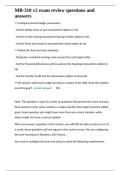Mb 310 - Study guides, Class notes & Summaries
Looking for the best study guides, study notes and summaries about Mb 310? On this page you'll find 53 study documents about Mb 310.
All 53 results
Sort by
MB 310 – Finance exam review 2024
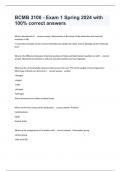
-
BCMB 3100 - Exam 1 Spring 2024 with 100% correct answers
- Exam (elaborations) • 23 pages • 2024
-
- $16.49
- + learn more
What is biochemistry? - correct answer Biochemistry is the study of the molecules and chemical reactions of life. -it uises the principles of one science (chemistry) to explain the other science (biology) at the molecular level. What is the difference between chemical reactions in flasks and biochemical reactions in cells? - correct answer Biochemical reactions in cells are cascade reactions and are regulated. What are the six nonmetallic elements that account for over 97% of the weig...

-
BCMB 3100 Exam 1 quizzes
- Exam (elaborations) • 14 pages • 2024
-
Available in package deal
-
- $12.49
- + learn more
Briefly describe Bartter's syndrome and the role of the gene KCNJ1. - Bartter's syndrome is a genetically inherited disease that causes excess salt loss and the hardening of kidney tissue. Type II Bartter's syndrome, which is antenatal, is caused by a mutation in the KCNJ1 gene. Mutations in KCNJ1 gene change/delete amino acids in ROMK which results in a dysfunctional/nonfunctional protein. ROMK moves potassium across kidney cell membranes so dysfunctional ROMK causes potassium deficiency i...
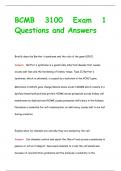
-
BCMB 3100 Exam 1 Questions and Answers
- Exam (elaborations) • 26 pages • 2024
- Available in package deal
-
- $12.49
- + learn more
Briefly describe Bartter's syndrome and the role of the gene KCNJ1. Answer> Bartter's syndrome is a genetically inherited disease that causes excess salt loss and the hardening of kidney tissue. Type II Bartter's syndrome, which is antenatal, is caused by a mutation in the KCNJ1 gene. Mutations in KCNJ1 gene change/delete amino acids in ROMK which results in a dysfunctional/nonfunctional protein. ROMK moves potassium across kidney cell membranes so dysfunctional ROMK causes pota...
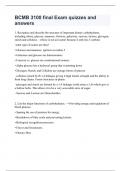
-
BCMB 3100 final Exam quizzes and answers
- Exam (elaborations) • 16 pages • 2024
-
Available in package deal
-
- $13.49
- + learn more
1. Recognize and describe the structure of important dietary carbohydrates including ribose, glucose, mannose, fructose, galactose, sucrose, lactose, glycogen, starch and cellulose - -ribose is not an isomer because it only has 5 carbons -what type of isomer are they? • Glucose and mannose: epimers at carbon 5 • Galactose and glucose are diastereomers • Fructose vs. glucose are constitutional isomers • Alpha glucose has a hydroxyl group that is pointing down -Glycogen, Starch, an...

-
BCMB 3100 Chapter 8 exam
- Exam (elaborations) • 10 pages • 2024
-
Available in package deal
-
- $11.99
- + learn more
The activity of an enzyme can be regulated by a: competitive inhibitor binding to the active site. competitive inhibitor binding to the ES complex. noncompetitive inhibitor binding to the ES complex. All of the above Only the first and third answers are correct. - Only the first and third answers are correct. In chymotrypsin, the catalytic triad is made up of which three amino acids? Asp, His, Cys Asp, His, Ser Asp, Asp, Ser Asn, His, Ser Asn, His, Cys - ...
BCMB 3100 - Exam 1 Spring 2024/25 | Rated A+
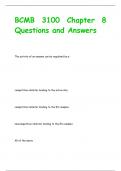
-
BCMB 3100 Chapter 8 Questions and Answers
- Exam (elaborations) • 16 pages • 2024
- Available in package deal
-
- $10.49
- + learn more
The activity of an enzyme can be regulated by a: competitive inhibitor binding to the active site. competitive inhibitor binding to the ES complex. noncompetitive inhibitor binding to the ES complex. All of the above Only the first and third answers are correct. Answer> Only the first and third answers are correct. In chymotrypsin, the catalytic triad is made up of which three amino acids? Asp, His, Cys Asp, His, Ser Asp, Asp, Ser Asn, His, Ser Asn, His, Cys Answer> Asp, His, ...
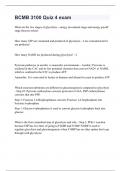
-
BCMB 3100 Quiz 4 exam
- Exam (elaborations) • 5 pages • 2024
-
Available in package deal
-
- $12.49
- + learn more
What are the two stages of glycolysis - energy investment stage and energy payoff stage (hexose-triose) How many ATP are consumed and produced in glycolysis - 2 are consumed and 4 are produced How many NADH are produced during glycolysis? - 2 Pyruvate pathways in aerobic vs anaerobic environments - Aerobic: Pyruvate is oxidized in the CAC and its low potential electrons then convert NAD+ to NADH, which is oxidized in the ETC to produce ATP Anaerobic: It is converted to lactate in human...
MB-310 v2 exam review questions and answers

How much did you already spend on Stuvia? Imagine there are plenty more of you out there paying for study notes, but this time YOU are the seller. Ka-ching! Discover all about earning on Stuvia





